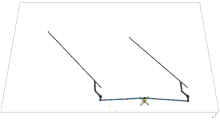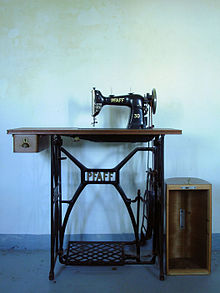crank

A rotating crank drives via a respective coupling rod two reciprocal turning ( "swinging") wipers on.
A crank is a rod-shaped, at one end in a machine frame rotatable machine element . At the free outer end there is a handle ( hand crank ) fastened at right angles to the rod or a pedal ( pedal crank ) or an articulated connection to a mostly rod-shaped link for coupling a coupling gear . The handle can be rotatably mounted about its axis of symmetry so that there is no relative movement between it and the hand. Pedals usually rotate around their axis of symmetry (see bicycle pedal ).
Drive the crank
Force introduction at the free outer end
At the outer end, a force can be introduced which, at the other end, serves as torque on a shaft that can be rotated with the crank to drive a device or a machine . For example, small kitchen appliances ( hand mixer ) or office equipment ( pencil sharpener ) are driven with a hand crank .
In addition to bicycles , cranks can also be found in other work equipment driven by muscle power, such as sewing machines or spinning wheels . With the latter, however, the crank itself is not driven directly, but via a coupling rod by a rhythmically stepped foot rocker (rocker, see crank rocker ). Such cranks act on a flywheel that drives the implement via a belt .
Cranks that serve as operating elements are referred to as hand cranks as well as the lyre , whereby it is not the force introduced but the direction of rotation and the extent of the rotation that are important.
String winders help to pull the strings on certain musical instruments.

Torque introduction at the end stored in the frame
When rotation and torque are introduced at the inner end of the crank (from the frame) and another element articulated at the outer end is driven, the flow of energy through the crank is the opposite of that in the "original crank" (hand crank).
In the case of coupling gears , the crank is the mostly revolving ("crank rotation") link that drives the other parts of the gear.
Cranks that do not fully rotate around their joint fixed to the frame, but only pivot back and forth , are also referred to in some contexts as rocker arms or crank arms or just handlebars . An example of non-rotating cranks is the crank arm axle , a wheel suspension in vehicle construction . Since it is a parallel crank gear, there are two non-rotating "crank arms" in this application.
The crankshaft ( crank ) of steam or combustion engine is powered by a piston ( push member ) via a connecting rod ( connecting rod driven). Pistons, (possibly extra cross head ) connecting rod and crankshaft together form a crank drive .
history

Remains of a Roman crank mill from the late 2nd century AD were excavated in Aschheim , Bavaria ; With the help of the approx. 40 cm long iron crank, the millstone was driven manually via a gear train. Another Roman crank was found in Augusta Raurica ( Switzerland ). The piece of iron, 82.5 cm long, has a 15 cm long handle and reached the ground by 250 AD at the latest. Its exact function is still unknown.
The water-powered sawmill depicted on the sarcophagus of Marcus Aurelius Ammianos in the Roman era Hierapolis contains a crank drive that, driven by a water wheel , allows the gates of a stone saw to move back and forth.
“By deciphering a relief from Hierapolis in Phrygia (2nd half of the 3rd century AD) it is now clear with what technical sophistication antiquity has approached this problem: the power transmission from a waterwheel via gearwheels, crankshaft and push rods The relief is finely carved out on a double stone saw. It could be the first pictorial representation of a gear drive in the history of technology. "
Two other late antique sawmills in Ephesus and Gerasa are also known, in which the rotary movement of the water wheel was converted into a linear movement in the same way by a crank drive.
The drive of machines and devices by hand or with the foot only declined in the time of the industrial revolution , when smaller and independent of natural conditions power machines such as water and wind turbines became available. Steam engines , internal combustion engines and electric motors could now be used in factories . Since then, electric motors and combustion engines for vehicles have been used for individual use. For a long time, only the hand crank was required to start the latter . Nostalgic devices like the barrel organ are still operated today with a hand crank.
Web links
Individual evidence
- ↑ Volpert, Hans-Peter: "A Roman crank mill from Aschheim, district Munich", in: Report of the Bavarian Bodendenkmalpflege , Vol. 38 (1997), pp. 193–199
- ↑ Laur-Belart, Rudolf: "Guide through Augusta Raurica", 5th edition, August 1988, pp. 51–52, 56, fig. 42
- ↑ Grewe, Klaus: "The relief representation of an ancient stone saw machine from Hierapolis in Phrygia and its significance for the history of technology" International conference 13. – 16. June 2007 in Istanbul "(PDF file; 1.89 MB), in: Bachmann, Martin (Hrsg.): Construction technology in ancient and pre-ancient Asia Minor , Byzas, vol. 9, Istanbul 2009, ISBN 978-975-807-223 -1 , pp. 429-454
- ↑ Ritti, Tullia; Grewe, Klaus; Kessener, Paul: "A Relief of a Water-powered Stone Saw Mill on a Sarcophagus at Hierapolis and its Implications", in: Journal of Roman Archeology , Vol. 20 (2007), pp. 138–163 (149–153)

